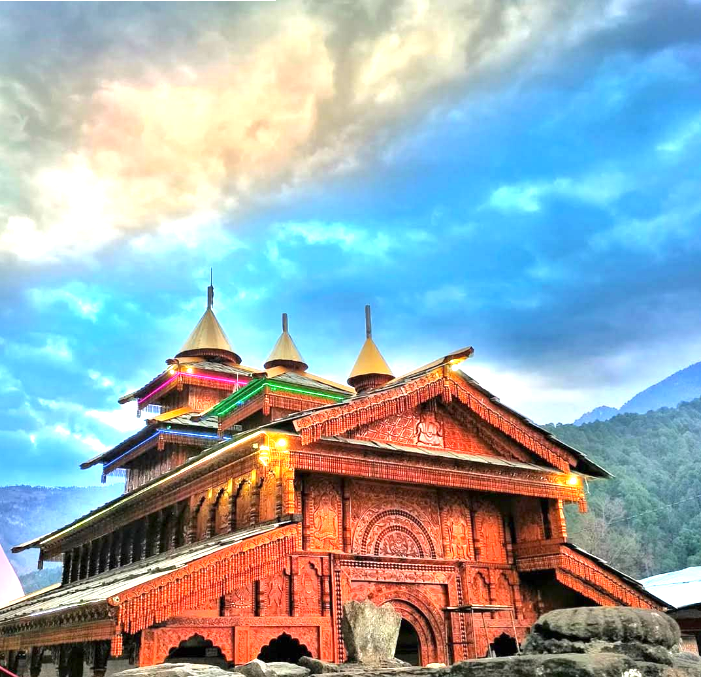A Hidden Spiritual Oasis in Barkot, Uttarakhand
High in the folds of the Garhwal Himalayas, where pine forests echo ancient chants and the cool winds whisper stories of sages, lies Jamadagni Rishi Temple in the serene hamlet of Than (ब्रह्मपुरी), near Barkot, Uttarkashi. This temple, dedicated to Rishi Jamadagni, one of the revered Saptarishis in Hindu mythology, offers a rare mix of divine history, peaceful nature, and spiritual depth.

Who Was Rishi Jamadagni?
Rishi Jamadagni was one of the seven great sages (Saptarishis) and a son of sage Rishi Bhrigu. A powerful and deeply disciplined ascetic, Jamadagni is best known as the father of Lord Parshuram, the sixth avatar of Vishnu. The stories of his unwavering discipline, knowledge of divine weapons, and strict adherence to dharma are foundational parts of Vedic lore.
His ashram at Than (ब्रह्मपुरी) is believed to be one of the places where he meditated and performed rigorous penance. According to local belief, this is where he received divine revelations and taught his son Parshuram the sacred texts and celestial warfare.
📍 Location and Setting
The Than village, locally called ब्रह्मपुरी, lies about 14 kilometers from Barkot, nestled amidst thick pine groves and quiet Himalayan slopes. The walk or drive to the ashram is peaceful and scenic, often accompanied by the chirping of birds, distant temple bells, and the rustling of deodar trees.
The Jamadagni Rishi Temple stands humbly yet with grace, surrounded by stone-paved paths and village homes. The temple’s architecture is simple, made from wood and stone with a sloped roof characteristic of traditional Pahadi craftsmanship. Inside, the sanctum holds a shila (sacred stone) and a murti (idol) representing the sage, worshipped daily by the local Brahmin priest.
Spiritual Significance
This temple is more than just a place of worship—it’s a living ashram, where silence speaks louder than rituals, and peace flows like the Yamuna nearby. Pilgrims visit to meditate, perform tarpan (ancestor rituals), and connect with the ancient wisdom of the rishis. It is especially revered during Guru Purnima and Amavasya nights, when locals perform night-long bhajans and fire rituals.
The energy of the space is calm yet intense. Locals say that if you sit quietly near the shrine for long enough, you feel the presence of the Rishi — stern yet compassionate, watching over his homeland even now.
The Journey to the Temple
From Barkot, travelers can either:
- Drive to Than (ब्रह्मपुरी) — narrow but motorable road (16-18 minutes).
- Or Trek via forest trails — a 3–4 km hike filled with Himalayan flora, birds, and occasional langurs.
The forest trail is especially recommended for those seeking a deeper experience — walking slowly through nature as ancient rishis once did.
Mythological Lore: The Axe of Parshuram
One of the most intriguing legends associated with the area is that of Lord Parshuram’s Axe. It is said that Parshuram received his celestial axe from his father, Rishi Jamadagni, after proving his worth through devotion and obedience. The vibrations of that ancient exchange still linger in the soil of Brahmpuri, say the villagers.
Some also claim that Rishi Jamadagni’s original manuscripts—sacred scrolls written on bhojpatra (birch bark) were kept in this ashram and are now spiritually protected by nature itself.
Nature and Tranquility
Beyond its spiritual charm, the temple is also a perfect getaway for nature lovers. The views from Than overlook valleys blanketed in mist, river streams glistening in the sun, and terraced fields worked by local villagers in the old ways. Meditation here comes naturally—your body may sit still, but your mind begins to wander toward timeless realms.
The area is also a haven for birdwatchers and herbal enthusiasts. Local guides can show you wild medicinal plants, some of which were used by the sages for healing and spiritual practices.
Local Culture and Rituals
Every evening, a simple aarti (lamp ceremony) is performed with conch shells and bells. Villagers gather barefoot, women in traditional ghaghras, men with woolen shawls, offering rice, ghee, and wildflowers. The experience is grounding, authentic, and humbling – far removed from the crowds of bigger pilgrim centers.
During festivals like Navratri and Mahashivratri, special pujas are organized, and the temple sees a flow of devotees from neighboring villages like Kharadi, Gangnani, and Hanuman Chatti.
🧳 Tips for Visitors
- Best Time to Visit: March–June and September–November
- Dress Code: Modest and respectful
- What to Carry: Water bottle, small offering (coconut, ghee, incense), camera (optional but discreet)
- Stay Options: Barkot hotels like Hotel Shivlinga Villa, or homestays in Than
- Local Guide: Recommended for history and folklore
A Place Beyond Time
Jamadagni Rishi Temple in Than (ब्रह्मपुरी) is not just a spot on a tourist map. It is an invitation to pause, to listen to the earth, and to remember the values of discipline, humility, and inner strength. In a world that moves fast, places like these teach us to slow down, to reconnect with the self, and to find wisdom not in words, but in silence.
If you ever find yourself in Barkot, take the detour – up the ridge, into the forest, and toward the whispers of a sage who never left.
